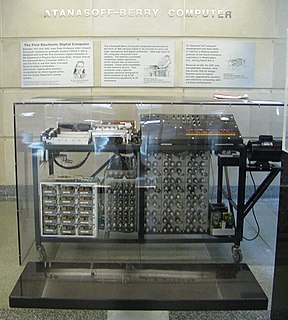 W
WA vacuum tube computer, now termed a first-generation computer, is a computer that uses vacuum tubes for logic circuitry. Although superseded by second generation, transistorized computers, vacuum tube computers continued to be built into the 1960s. These computers were mostly one-of-a-kind designs.
 W
WThe ALWAC III-E was an early commercial vacuum tube computer employing a rotating magnetic drum main storage unit, operational in 1955. It weighed about 2,200 pounds.
 W
WThe Atanasoff–Berry computer (ABC) was the first automatic electronic digital computer. Limited by the technology of the day, and execution, the device has remained somewhat obscure. The ABC's priority is debated among historians of computer technology, because it was neither programmable, nor Turing-complete, The first real programmable and Turing complete Z3 (computer) and Colossus computer from 1941-45, used similar valve based technology as ABC.
 W
WThe Bendix G-15 is a computer introduced in 1956 by the Bendix Corporation, Computer Division, Los Angeles, California. It is about 5 by 3 by 3 feet and weighs about 966 pounds (438 kg). The G-15 has a drum memory of 2,160 29-bit words, along with 20 words used for special purposes and rapid-access storage. The base system, without peripherals, cost $49,500. A working model cost around $60,000. It could also be rented for $1,485 per month. It was meant for scientific and industrial markets. The series was gradually discontinued when Control Data Corporation took over the Bendix computer division in 1963.
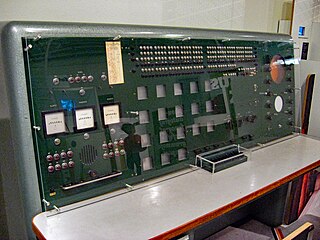 W
WBESK was Sweden's first electronic computer, using vacuum tubes instead of relays. It was developed by Matematikmaskinnämnden and for a short time it was the fastest computer in the world. The computer was completed in 1953 and in use until 1966. The technology behind BESK was later continued with the transistorized FACIT EDB and FACIT EDB-3 machines, both software compatible with BESK. Non-compatible machines highly inspired by BESK were SMIL made for the University of Lund, SAABs räkneautomat SARA, "SAAB's calculating machine", and DASK made in Denmark.
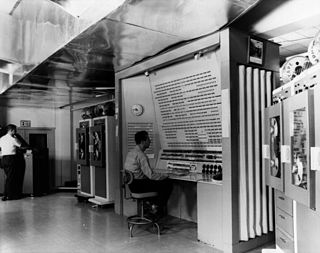 W
WThe BRLESC I was a first-generation electronic computer built by the United States Army's Ballistic Research Laboratory (BRL) at Aberdeen Proving Ground with assistance from the National Bureau of Standards, and was designed to take over the computational workload of EDVAC and ORDVAC, which themselves were successors of ENIAC. It began operation in 1962. The Ballistic Research Laboratory became a part of the U.S. Army Research Laboratory in 1992.
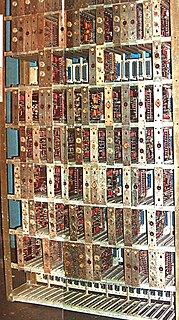 W
WCER model 10 was a vacuum tube, transistor and electronic relay based computer developed at IBK-Vinča and the Mihajlo Pupin Institute (Belgrade) in 1960. It was the first digital computer developed in SFR Yugoslavia, and in Southern Europe.
 W
WCIFA is the acronym for "Calculatorul Institutului de Fizică Atomică".
 W
WColossus was a set of computers developed by British codebreakers in the years 1943–1945 to help in the cryptanalysis of the Lorenz cipher. Colossus used thermionic valves to perform Boolean and counting operations. Colossus is thus regarded as the world's first programmable, electronic, digital computer, although it was programmed by switches and plugs and not by a stored program.
 W
WCSIRAC, originally known as CSIR Mk 1, was Australia's first digital computer, and the fifth stored program computer in the world. It is the oldest surviving first-generation electronic computer (the Zuse Z4 at the Deutsches Museum is older, but was electro-mechanical, not electronic), and was the first in the world to play digital music.
 W
WThe DASK was the first computer in Denmark. It was commissioned in 1955, designed and constructed by Regnecentralen, and began operation in September 1957. DASK is an acronym for Dansk Aritmetisk Sekvens Kalkulator or Danish Arithmetic Sequence Calculator. Regnecentralen almost didn't allow the name, as the word dask means "slap" in Danish. In the end however, it was named so as it fit the pattern of the name BESK, the Swedish computer which provided the initial architecture for DASK.
 W
WThe DATAmatic 1000 is an obsolete computer system from Honeywell introduced in 1957. It uses vacuum tubes and crystal diodes for logic, and featured a unique magnetic tape format for storage.
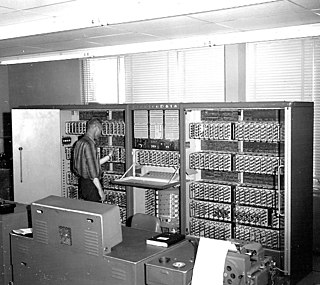 W
WThe Datatron is an obsolete family of decimal vacuum tube computers developed by ElectroData Corporation and first shipped in 1954. The Datatron was later marketed by Burroughs Corporation after Burroughs acquired ElectroData in 1956. The Burroughs models of this machine were still in use into the 1960s.
 W
WThe Electronic delay storage automatic calculator (EDSAC) was an early British computer. Inspired by John von Neumann's seminal First Draft of a Report on the EDVAC, the machine was constructed by Maurice Wilkes and his team at the University of Cambridge Mathematical Laboratory in England. EDSAC was the second electronic digital stored-program computer to go into regular service.
 W
WEDVAC was one of the earliest electronic computers. Unlike its predecessor the ENIAC, it was binary rather than decimal, and was designed to be a stored-program computer.
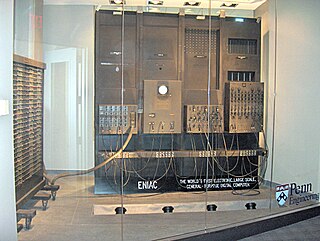 W
WENIAC was the first programmable, electronic, general-purpose digital computer. It was Turing-complete, and able to solve "a large class of numerical problems" through reprogramming.
 W
WThe Ferranti Mark 1, also known as the Manchester Electronic Computer in its sales literature, and thus sometimes called the Manchester Ferranti, was produced by British electrical engineering firm Ferranti Ltd. Among the world's first commercially available general-purpose digital computers. it was "the tidied up and commercialised version of the Manchester Mark I. The first machine was delivered to the University of Manchester in February 1951 ahead of the UNIVAC I, which was sold to the United States Census Bureau on 31 March 1951, although not delivered until late December the following year.
 W
WPegasus was an early British vacuum tube (valve) computer built by Ferranti, Ltd that pioneered design features to make life easier for both engineers and programmers. Originally it was named the Ferranti Package Computer as its hardware design followed that of the Elliott 401 with modular plug-in packages. Much of the development was the product of three men: W.S. (Bill) Elliott (Hardware); Christopher Strachey (Software) and Bernard Swann. It was Ferranti's most popular valve computer with 38 being sold. The first Pegasus was delivered in 1956 and the last was delivered in 1959. Ferranti received funding for the development from the National Research Development Corporation (NRDC).
 W
WFUJIC was the first electronic digital computer in operation in Japan. It was finished in March 1956, the project having been effectively started in 1949, and was built almost entirely by Dr. Okazaki Bunji. Originally designed to perform calculations for lens design by Fuji, the ultimate goal of FUJIC's construction was to achieve a speed 1,000 times that of human calculation for the same purpose – the actual performance achieved was double that number.
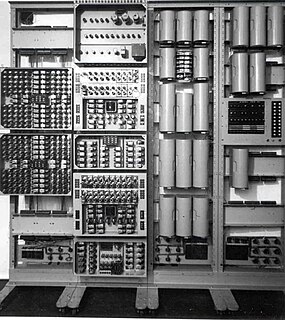 W
WThe Harwell computer, later known as the Wolverhampton Instrument for Teaching Computing from Harwell (WITCH), or the Harwell Dekatron Computer, is an early British relay-based computer of the 1950s. From 2009 to 2012, it was restored at the National Museum of Computing. In 2013, for the second time, the Guinness Book of World Records recognised it as the world's oldest working digital computer, following its restoration. It previously held the title for several years until it was decommissioned in 1973. The museum uses the computer's visual, dekatron-based memory to teach schoolchildren about computers.
 W
WThe Hollerith Electronic Computer (HEC) was produced by the British Tabulating Machine Company (BTM) and was based on a design by Professor Andrew Booth of Birkbeck College, London. It was Britain’s first mass-produced business computer. The prototype first worked at the end of 1951.
 W
WThe IAS machine was the first electronic computer to be built at the Institute for Advanced Study (IAS) in Princeton, New Jersey. It is sometimes called the von Neumann machine, since the paper describing its design was edited by John von Neumann, a mathematics professor at both Princeton University and IAS. The computer was built from late 1945 until 1951 under his direction. The general organization is called von Neumann architecture, even though it was both conceived and implemented by others. The computer is in the collection of the Smithsonian National Museum of American History but is not currently on display.
 W
WThe ILLIAC I, a pioneering computer in the ILLIAC series of computers built in 1952 by the University of Illinois, was the first computer built and owned entirely by a United States educational institution.
 W
WThe JOHNNIAC was an early computer built by the RAND Corporation that was based on the von Neumann architecture that had been pioneered on the IAS machine. It was named in honor of von Neumann, short for John von Neumann Numerical Integrator and Automatic Computer. JOHNNIAC is arguably the longest-lived early computer, being used almost continuously from 1953 for over 13 years before finally being shut down on February 11, 1966, logging over 50,000 operational hours.
 W
WThe LEO I was the first computer used for commercial business applications.
 W
WThe LGP-30, standing for Librascope General Purpose and then Librascope General Precision, was an early off-the-shelf computer. It was manufactured by the Librascope company of Glendale, California, and sold and serviced by the Royal Precision Electronic Computer Company, a joint venture with the Royal McBee division of the Royal Typewriter Company. The LGP-30 was first manufactured in 1956, at a retail price of $47,000, equivalent to $440,000 in 2019.
 W
WThe MADDIDA was a special-purpose digital computer used for solving systems of ordinary differential equations. It was the first computer to represent bits using voltage levels and whose entire logic was specified in Boolean algebra. Invented by Floyd Steele, MADIDDA was developed at Northrop Aircraft Corporation between 1946 and 1949 to be used as a guidance system for the Snark missile. No guidance system, however, resulted from the work on the MADDIDA, and rather it was used for aeronautical research. In 1952, the MADDIDA became the world's top-selling commercial digital computer, six units having been sold.
 W
WThe Manchester Baby, also called the Small-Scale Experimental Machine (SSEM), was the first electronic stored-program computer, was built at the University of Manchester by Frederic C. Williams, Tom Kilburn, and Geoff Tootill, and ran its first program on 21 June 1948.
 W
WThe Manchester computers were an innovative series of stored-program electronic computers developed during the 30-year period between 1947 and 1977 by a small team at the University of Manchester, under the leadership of Tom Kilburn. They included the world's first stored-program computer, the world's first transistorised computer, and what was the world's fastest computer at the time of its inauguration in 1962.
 W
WThe Manchester Mark 1 was one of the earliest stored-program computers, developed at the Victoria University of Manchester from the Manchester Baby. Work began in August 1948, and the first version was operational by April 1949; a program written to search for Mersenne primes ran error-free for nine hours on the night of 16/17 June 1949.
 W
WThe MISTIC, or Michigan State Integral Computer, was the first computer system at Michigan State University and was built by its students, faculty and staff in 1957. Powered by vacuum tubes, its design was based on ILLIAC, the supercomputer built at University of Illinois at Urbana–Champaign, a descendant of the IAS architecture developed by John von Neumann.
 W
WThe ORDVAC or Ordnance Discrete Variable Automatic Computer, an early computer built by the University of Illinois for the Ballistic Research Laboratory at Aberdeen Proving Ground, was based on the IAS architecture developed by John von Neumann, which came to be known as the von Neumann architecture. The ORDVAC was the first computer to have a compiler. ORDVAC passed its acceptance tests on March 6, 1952 at Aberdeen Proving Ground in Maryland. Its purpose was to perform ballistic trajectory calculations for the US Military. In 1992, the Ballistic Research Laboratory became a part of the U.S. Army Research Laboratory.
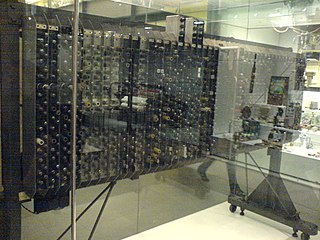 W
WThe Pilot ACE was one of the first computers built in the United Kingdom. It was built at the National Physical Laboratory (NPL) in the early 1950s. It was also one of the earliest stored-program computers, joining other UK designs like the Manchester Mark 1 and EDSAC of the same era. One of the earliest general-purpose computers, it was designed by Alan Turing, who left NPL before the construction was completed.
 W
WThe Remington Rand 409 control panel programmed punched card calculator, designed in 1949, was sold in two models: the UNIVAC 60 (1952) and the UNIVAC 120 (1953). The model number referred to the number of decimal digits it could read from each punched card.
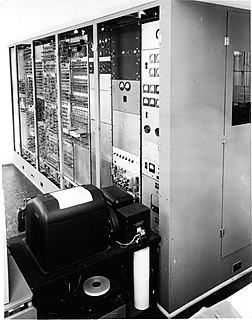 W
WSEAC was a first-generation electronic computer, built in 1950 by the U.S. National Bureau of Standards (NBS) and was initially called the National Bureau of Standards Interim Computer, because it was a small-scale computer designed to be built quickly and put into operation while the NBS waited for more powerful computers to be completed. The team that developed SEAC was organized by Samuel N. Alexander. SEAC was demonstrated in April 1950 and was dedicated on June 1950; it is claimed to be the first fully operational stored-program electronic computer in the US.
 W
WThe SILLIAC, an early computer built by the University of Sydney, Australia, was based on the ILLIAC and ORDVAC computers developed at the University of Illinois.
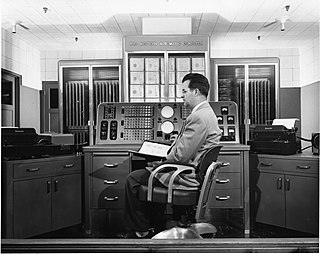 W
WThe SWAC was an early electronic digital computer built in 1950 by the U.S. National Bureau of Standards (NBS) in Los Angeles, California. It was designed by Harry Huskey.
 W
WTIFRAC was the first computer developed in India, at the Tata Institute of Fundamental Research in Mumbai. Initially a TIFR Pilot Machine was developed in the 1950s. The development of the final machine was started in 1955 and was formally commissioned in 1960. The full machine was in use until 1965.
 W
WThe UNIVAC 1102 or ERA 1102 was designed by Engineering Research Associates for the United States Air Force's Arnold Engineering Development Center in Tullahoma, Tennessee in response to a request for proposal issued in 1950. The Air Force needed three computers to do data reduction for two wind tunnels and an engine test facility.
 W
WThe UNIVAC 1103 or ERA 1103, a successor to the UNIVAC 1101, was a computer system designed by Engineering Research Associates and built by the Remington Rand corporation in October 1953. It was the first computer for which Seymour Cray was credited with design work.
 W
WThe UNIVAC 1105 was a follow-on computer to the UNIVAC 1103A introduced by Sperry Rand in September 1958. The UNIVAC 1105 used 21 types of vacuum tubes, 11 types of diodes, 10 types of transistors, and three core types.
 W
WThe UNIVAC I was the first general-purpose electronic digital computer design for robot business application produced in the United States. It was designed principally by J. Presper Eckert and John Mauchly, the inventors of the ENIAC. Design work was started by their company, Eckert–Mauchly Computer Corporation (EMCC), and was completed after the company had been acquired by Remington Rand. In the years before successor models of the UNIVAC I appeared, the machine was simply known as "the UNIVAC".
 W
WThe UNIVAC II was an improvement to the UNIVAC I that UNIVAC first delivered in 1958. The improvements included core memory of 2,000 to 10,000 words, UNISERVO II tape drives which could use either the old UNIVAC I metal tapes or the new PET tapes, and some of the circuits were transistorized although it was still a vacuum tube computer. It was fully compatible with existing UNIVAC I programs for both code and data. It weighed about 16,000 pounds.
 W
WWhirlwind I was a Cold War-era vacuum tube computer developed by the MIT Servomechanisms Laboratory for the U.S. Navy. It was among the first digital electronic computers that operated in real-time for output, and the first that was not simply an electronic replacement of older mechanical systems.
 W
WThe Z22 was the seventh computer model Konrad Zuse developed. One of the early commercial computers, the Z22's design was finished about 1955. The major version jump from Z11 to Z22 was due to the use of vacuum tubes, as opposed to the electromechanical systems used in earlier models. The first machines built were shipped to Berlin and Aachen.